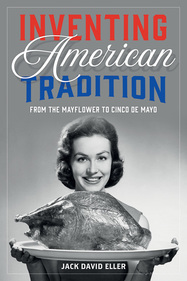Inventing American Tradition
- By Jack David Eller
- Reaktion Books
- 352 pp.
- Reviewed by Larry Matthews
- November 24, 2019
How much do you know about your favorite customs and characters?

Jack David Eller’s Inventing American Tradition is the ideal book to read before the relatives gather for Thanksgiving, especially for family smart alecks who like to blurt out obscure facts during dinner.
Eller is a retired assistant professor of anthropology at the Community College of Denver. His earlier books have looked at America’s culture from religion to violence. Inventing American Tradition is about who we are and what we see reflected as “us.”
He begins with our national anthem, “The Star-Spangled Banner,” which, he says, “began in 1814, during a barely remembered clash in a barely remembered war.” That would be the War of 1812. The “clash” was the battle of Ft. McHenry in Baltimore Harbor.
As it happened, a prominent local citizen named Francis Scott Key was aboard a British warship in the harbor, trying to win the release of an American being held prisoner. He witnessed the battle and wrote a poem that began, “O say can you see, by the dawn’s early light.”
The poem was set to the music of an English drinking song, and today it’s played at virtually every sporting event in the country. It was not always popular, however. A tune called “Hail Columbia” was more of a favorite at the time.
Eller notes that it’s unlikely Betsy Ross sewed the first American flag. He quotes historian Morris Vogel: “It is the immaculate conception: George Washington comes to visit and the flag literally issues forth from Betsy’s lap.” The myth was aided by Ross’ nephew Lloyd Balderson, who had his own reason for pushing the story — namely, fame for the family’s tailor shop in Philadelphia. Eller informs us that no one really knows who sewed the first flag.
It’s the same with the character Uncle Sam. The letters “U.S.” were in common use before the War of 1812, but how they became Uncle Sam is clouded in myth. One story has it that a man named Samuel Wilson, known as “Uncle Sam,” supplied meat to the U.S. Army during the war. His barrels were labeled “U.S.,” and one thing led to another. There’s no real evidence that it’s true, though.
As for Thanksgiving, that most revered of American holidays, we were taught that it was the Pilgrims in Massachusetts who, with their Indian friends, gave thanks and, in the bargain, gave us the holiday. Eller points out that, while the tale is accurate, the Pilgrims were a solemn bunch who didn’t believe in holidays and never celebrated Thanksgiving again. (Besides, feasts of thanks were common well before the Pilgrims ate their turkey.)
Mother’s Day, that excess of dinner reservations and Hallmark cards, was first observed in West Virginia in the early 1850s, “to teach proper mothering and parenting skills to local women,” according to Eller. Its later popularity was promoted by a woman named Anna Jarvis, who had no children. She wanted to honor her own mother.
Eller takes us through a dizzying list of holidays and products and lifestyle items. He notes that “OK” is the most common word in the English language as spoken in America and possibly in the entire world. He quotes a man named Woodford Heflin who, in 1941, proclaimed that, “OK is king of all American abbreviations. It is uttered probably one billion times a day in the United States, more or less…”
Okay, let’s pursue this. As with everything else, the tale’s origins are murky. One theory has the poorly educated President Andrew Jackson misspelling “all correct” as “oll korrect” and then abbreviating it “OK.” There is no evidence to back up this legend, but it has enjoyed a certain popularity.
And on we march to Coca-Cola, long the most popular drink in the world. Eller walks us through the invention of artificially carbonated water in 1819 and, naturally, the idea to mix it with flavored syrup. One of the first of these drinks was sold by a man named Charles Hires, who called his concoction “root beer.”
Coca soon became a popular ingredient in drinks. A fellow named John Stith Pemberton in Atlanta joined the crowd making “coca wine,” a mix of wine and extract of the coca leaf, the basic ingredient in cocaine. Pemberton’s “French Wine of Coca,” introduced in 1884, was not a hit. He removed the wine, added cola, and, boom! The “real thing” was born. (The coca extract was later removed.)
And so it goes through hamburgers, blue jeans, Superman, Mickey Mouse, the Lone Ranger, Rudolph the Red-Nosed Reindeer, and many more traditions, heroes, and products.
This is not a book for anyone looking for a serious read. Instead, it’s one to keep in the bathroom and leaf through when you, um, have a moment. You can place it next to the Guinness Book of World Records. Open it up anywhere, learn a thing or two, and get on with your day.
Just be warned: If, at Thanksgiving dinner, Uncle Leo shouts facts about the origin of the humble hamburger or Pledge of Allegiance, you’ll know he got to the book first.
[Editor's note: This review originally ran in 2018.]
Larry Matthews is the author of Age in Good Time: Lives and Lessons from Men in Their Seventies. His books can be found at www.larrymatthews.net.

